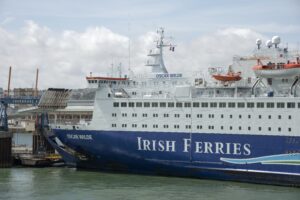
UK hopes that controversial Brexit checks on goods crossing the Irish sea can be eliminated have risen after early analysis of government data showed that at least 85% of goods arriving in Northern Ireland from Great Britain stay in factories or shops in the region.
The research comes from a new HM Revenue and Customs database, the EU Access system, that tracked the movement of 1m goods crossing the Irish Sea in 2021.
Under the Northern Ireland protocol, suppliers of goods to the region from Britain must complete customs declarations to move goods to Northern Ireland in order to avoid a border on the island of Ireland.
The requirement of the protocol has ruptured the political settlement in Northern Ireland, where the Democratic Unionist party refuses to sit in the devolved government.
The database, which the EU has been testing since 7 November, provides real-time customs and commercial data on everything from agrifood to tractor parts and manufacturing components being placed on ferries bound for Northern Ireland ports.
The UK hopes it will be provide EU officials with the data they need to monitor trade between Great Britain and Northern Ireland and reassure them that systems are in place to prevent rogue operators smuggling substandard goods across the border.
The data will not be published because it is commercially sensitive, but it is understood that early analysis in the UK shows that a sixth or 16% of goods by value were deemed at risk of crossing the border.
The 85% figure is unlikely to comfort the EU over the need for a border on the island of Ireland, although it is understood that a significant proportion of the goods classified as at risk of crossing the border remained in Northern Ireland, but were classified as such because the accompanying paperwork did not meet requirements.
The European Commission president, Ursula von der Leyen, said last week that a deal on the protocol was in reach if there was political will in the UK.
The database is considered central to any solution.
A government spokesperson said: “To meet the UK’s customs data sharing obligations, HMRC has delivered a new system called EU Access System. It provides real-time Northern Ireland data from five different HMRC systems in one place.
“The system has been operational since January 2022 and we have been working closely with the EU to ensure the system meets their needs.”
HMRC data released but not publicised in September shows “just over 1m full declarations were cleared for movements of goods into Northern Ireland from Great Britain” in 2021.
It is a small fraction of the overall trade conducted with the EU since Brexit, according to HMRC figures that show 34.3m declarations made by British businesses selling into Europe in 2021.
To resolve the protocol dispute, the UK is looking for a new “green lane and red lane” system to separate lorries destined for the Republic of Ireland from those staying in Northern Ireland.
It believes suppliers going through the green lane should not be required to fill in customs declarations. Suppliers have told the government they find requirements to list commodity codes for each item in a consignment as burdensome.
Instead the UK argues that commercial manifests, which list the contents, origin and destination of lorries on a ferry, are enough if the database works, and that a robust trusted trade system with hefty fines for rogue operators is a viable solution.
The EU’s proposal for an “express lane” is similar, but it still wants producers to complete customs declarations.
Maroš Šefčovič, the European Commission vice-president, recently told EU and UK parliamentarians at a meeting in Westminster that they were “not worlds apart”.
He said the EU proposals could reduce checks on lorries to two or three a day.
Read more:
New HMRC data raises UK hopes of end to Northern Ireland Brexit trade checks

